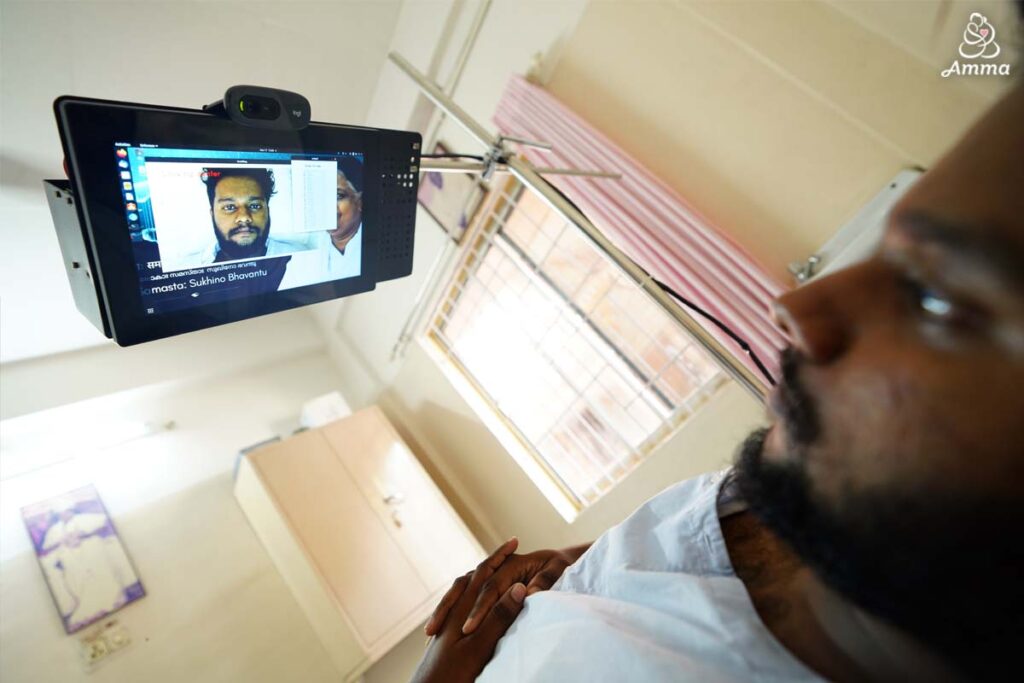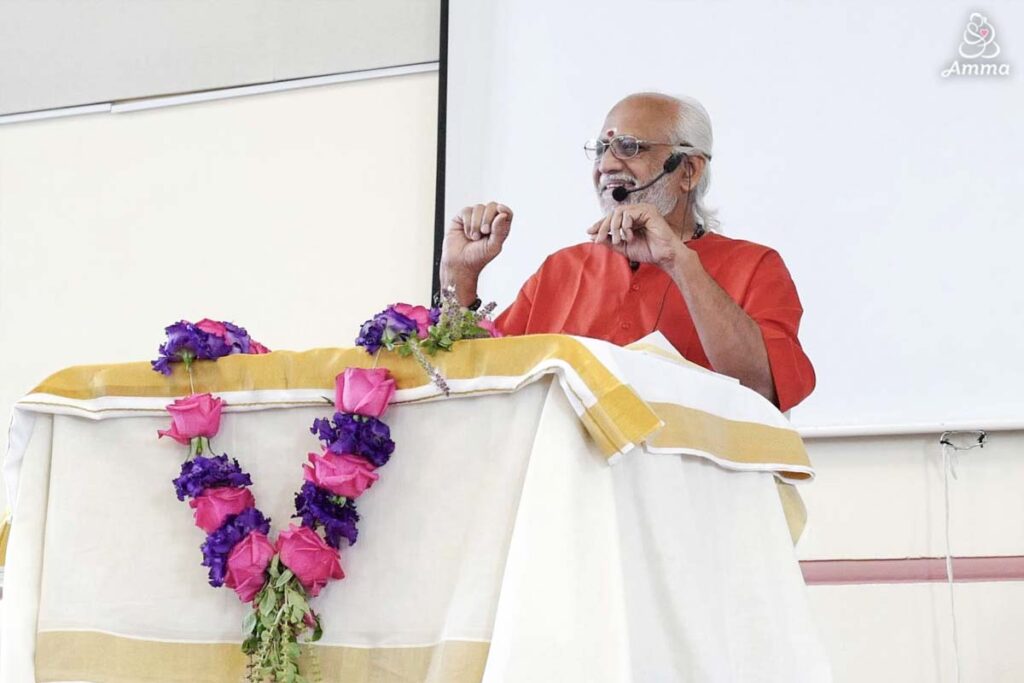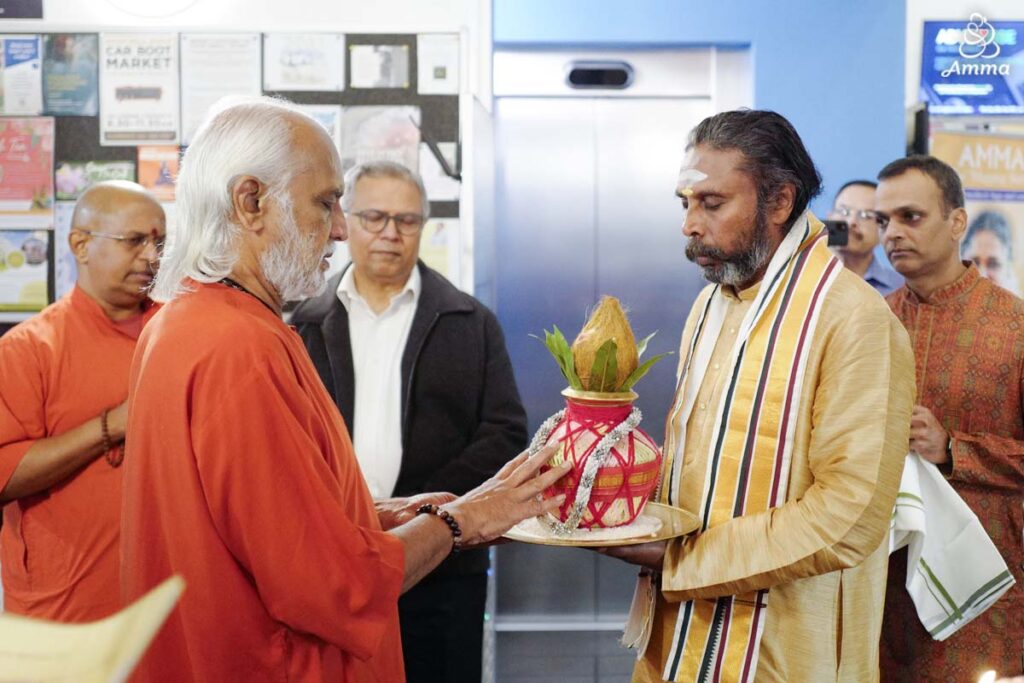Over 500,000 Saukhyam pads have been sold and distributed to-date helping prevent the emission of 2000 tons of carbon-dioxide equivalent annually. This has also helped eliminate an estimated 43,750 tons of non-biodegradable menstrual waste.
In March this year, the Saukhyam team was one of 75 purpose-driven teams given a Women Transforming India Award. The honor is bestowed by the Government of India’s Niti Aayog, a premier policy think-tank.
Ms. Anju Bist, one of the creators of Saukhyam Pads, received the award on behalf of Team Saukhyam. In this interview, she shares a brief history of how the project came to life and is now, on many levels, incorporated into the lives of women across India and around the world.
Where did the idea for Saukhyam come from?
When the Mata Amritanandamayi Math adopted backward village clusters in 2013, I was part of the team that traveled to rural areas helping begin free tuition classes for children and training health workers. Lack of proper means for menstrual hygiene leads to many education and health related problems for women and girls in rural India—this is what we saw. Tackle this one problem and we could potentially solve many more. This is what laid the foundation for the Saukhyam pads project.
What was your reaction when the project actually began?
Trees are cut to make cellulose fiber, the absorbent material in 99% of pads sold globally. In order to have more sanitary napkins reach more and more women and girls, we did not want to propose a solution where more trees were being cut. We looked at banana fiber, which is also a type of cellulose fiber but derived from agro-waste. The banana tree only fruits once, after which it is cut. Fiber is derived from cut trees and no living trees are harmed. Banana fiber is an excellent absorbent and our goal was to figure out how to make low-cost sanitary napkins from it.
But then Amma added another level, and her instructions were clear. She did not want us to make disposable sanitary napkins. We were to make reusable menstrual pads instead, using banana fiber as the absorbent. No one in the world had attempted such a thing before. Amma said, “Even though banana fiber comes from waste, it is still far too precious to be used once and thrown away.”
As a cloth pad user myself, I knew that reusables make for a much more wholesome period experience, so I was eager to try. With banana fiber, Saukhyam pads are even better than cloth pads that use cloth alone as the absorbent. They are lighter, cheaper, and very easy to use and reuse.

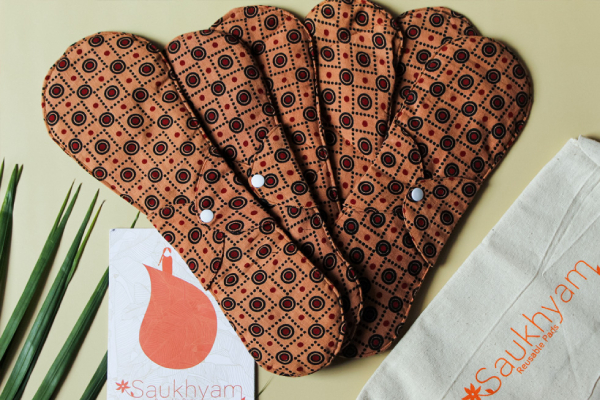
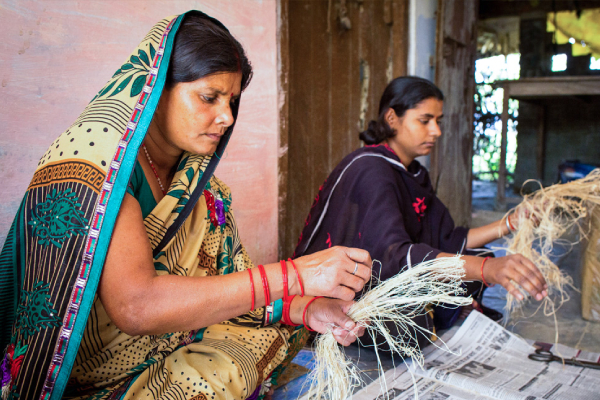
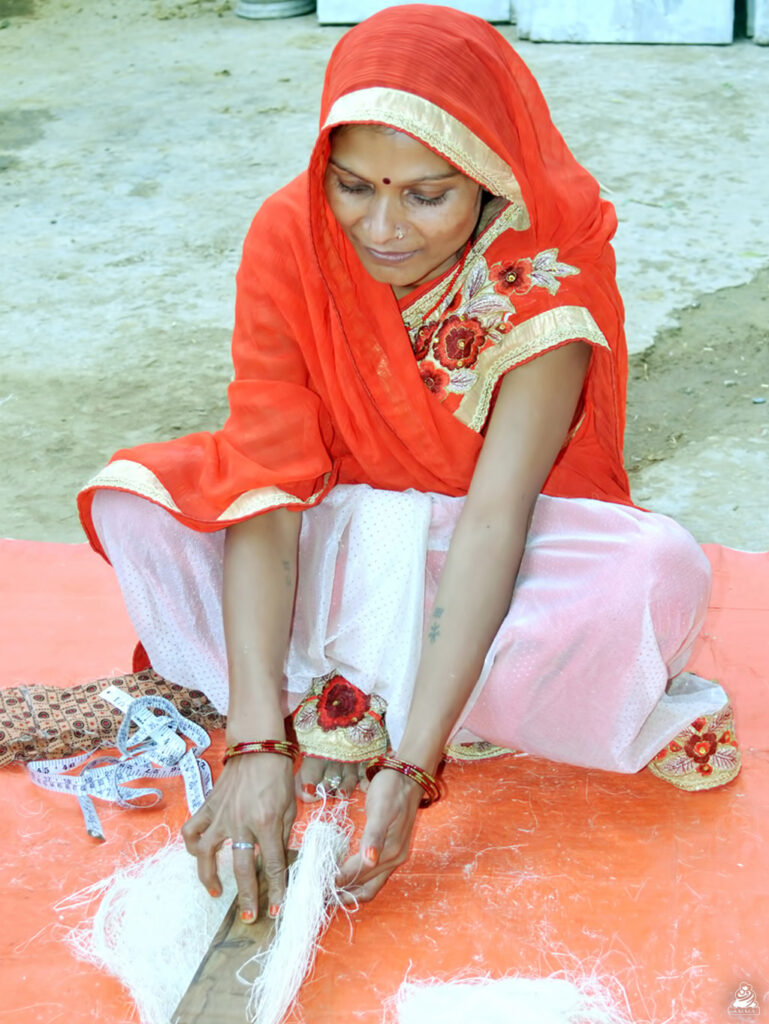
What were the first practical steps?
We needed to first create prototypes and test. This phase lasted two to three years, as we went through several iterations of design and redesign. After the prototype was finally given the thumbs-up by test users, we began production.
The first production center was in one of our adopted villages, and rural women were trained. They were quick to learn. Over time, they became very good in producing pads of excellent and consistent quality.
The banana fiber is cleaned and weighed before it is made into sheets of 6gm and 9gm each for the day and night pads. The sheets are then attached to the cloth with a zig zag stitch that Amma directly instructed us about. This kind of stitching helps hold the absorbent firmly in place. Over time, the women innovated other stitching techniques, as well, and that led to an increase in daily production numbers.
How did you reach women and girls to use the pads?
We began by conducting awareness workshops in rural areas, towns, and cities. We assembled a team of volunteers who helped schedule the workshops, especially in schools and colleges. In these sessions, the focus was never on sales. Instead, we shared facts about disposable sanitary napkins and reusable menstrual pads, elaborating on the environmental, health, and economic aspects.
Although the focus was not sales, these workshops usually led to sales as more and more women and girls were inspired to make changes to eco-friendly products that were cheaper and also better for their use.
Who are the different demographics?
Broadly speaking, we have seen two types of consumers who easily and readily make a shift. The first one is the younger consumer, who is more aware of environmental issues and eager to embrace solutions that are better for the planet. Saukhyam is the only brand of reusable pads that has custom sizes for teenagers. We have seen that teens and girls in their early twenties are usually easily able to make a shift. The older one is, and the longer one has used disposable sanitary napkins, the harder the struggle can be to get used to reusable pads.
The second set of users includes women and girls from families that are price-sensitive. With reusable pads, one can eliminate upto 90% of the recurring expense on sanitary napkins, and this is what makes it very attractive for these customers.
What are the different reactions?
The first thing that surprises those who make a shift is that reusable pads do not have the nasty smell one has been used to from disposable sanitary napkins. Our menstrual blood does not smell, but we go through an entire lifetime of not knowing that due to the awful smell of the disposable sanitary napkins.
Menstrual blood is a waste product, which is why the body lets it go, but it’s not in the same category of waste as urine and feces. If say, my body had conceived one month, then the same blood would have nourished the fetus. Handling a blood-soaked napkin to wash it is not such a big deal, after all, and that is what surprises users. Washing and drying is super easy; there are usually no stains to be scrubbed away; it’s like taking care of an extra piece of underwear during periods.
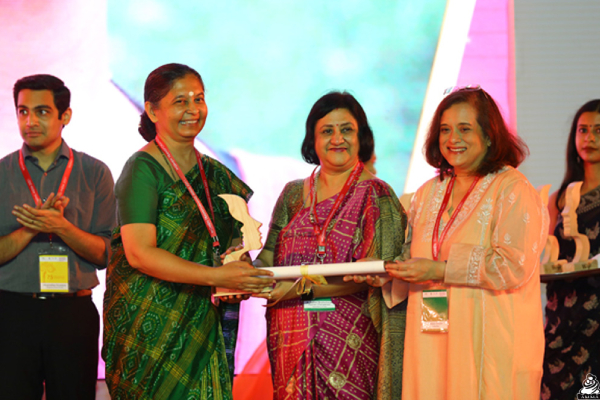
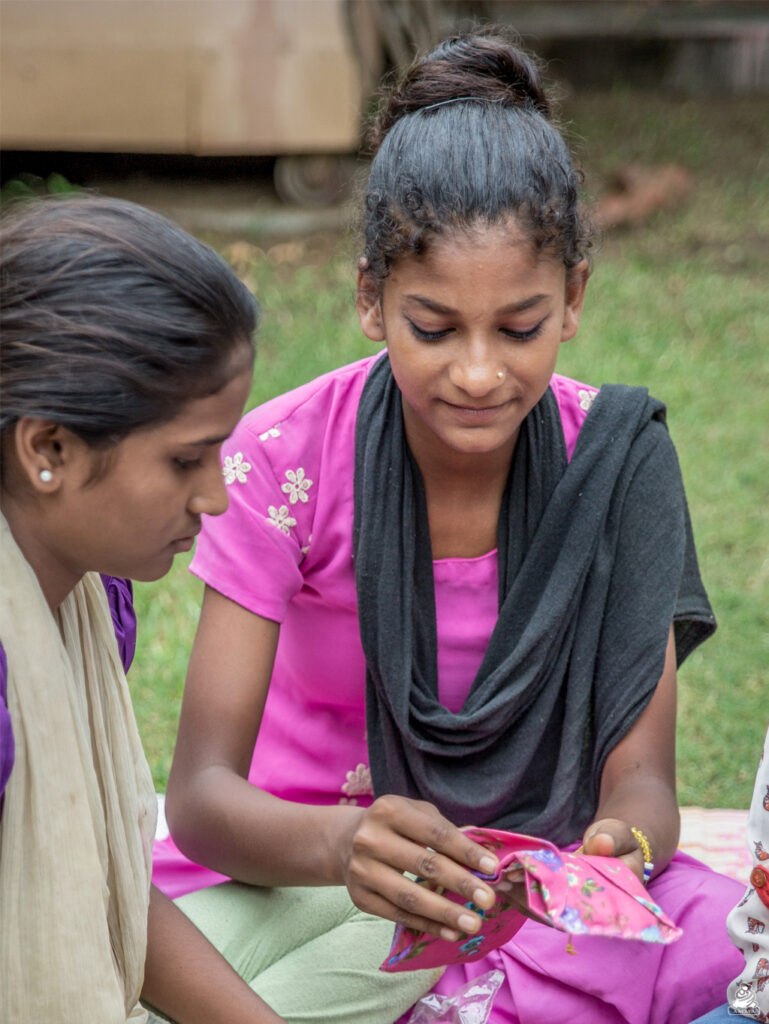
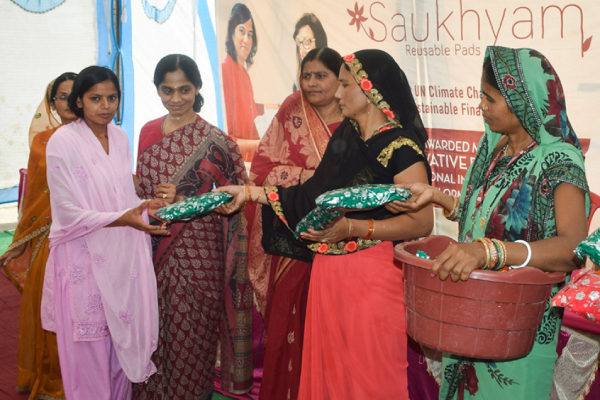
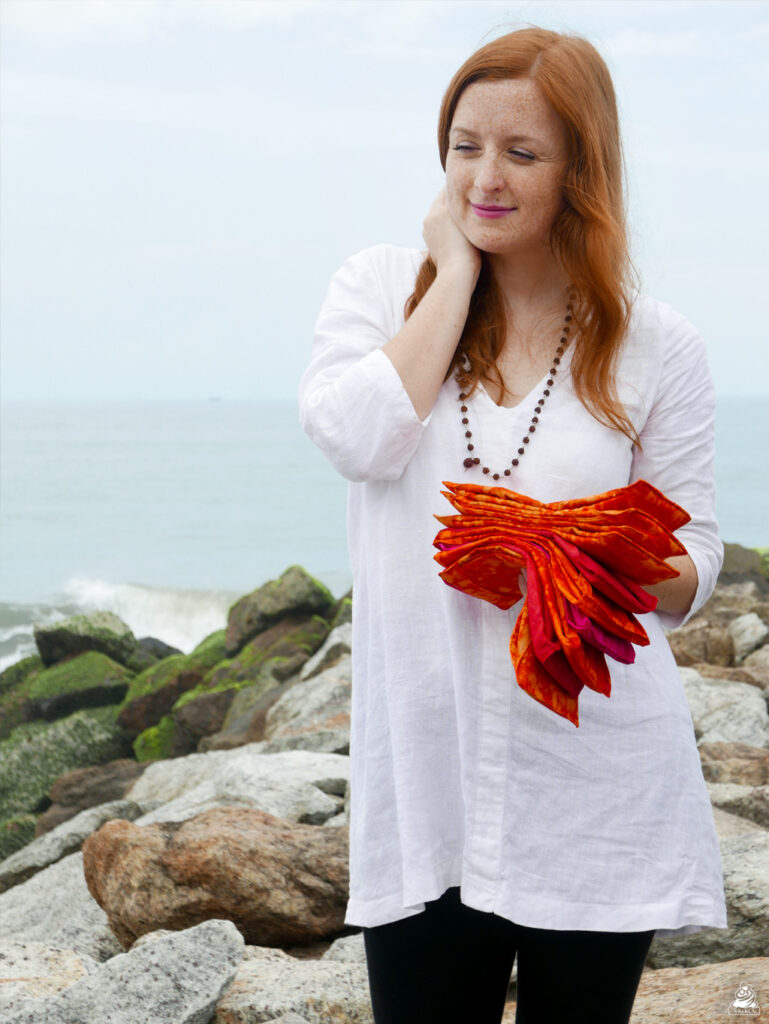
How easy are they to wash and dry?
Super easy, otherwise very few would be using them. We have 12 to 15 brands of reusable pads in India today, and we ourselves have seen the demand for these explode in the last few years. If washing and drying were tedious activities, hardly anyone would use reusable pads, regardless of how eco-friendly they were. Drying and washing, in fact, takes less time than having to go to the store month-after-month and purchasing sanitary napkins; this is what users say.
What has been the impact upon the women and girls who use them?
More than 90% of users report freedom from rashes after making the shift. Rashes commonly affect most users of disposable sanitary napkins, and this is one big beneficial impact that is noticeable immediately for most.
When we first began, Amma said, “Banana fiber has therapeutic qualities; these should be researched.”
We didn’t know at that time what to make of this statement, but now with so much anecdotal evidence of women and girls whose period cramps have reduced in intensity, whose periods have become more regular, and overall, the period experience has become much more wholesome, we understand a little better what Amma meant.
I have myself used cloth pads for two decades and know that reusables can indeed ensure a far better period experience. With banana fiber as the absorbent, reusable pads are even more nurturing for us. I say that as a user, and not because Saukhyam is our brand.
One important point that users reiterate again and again is that by making the shift to reusable pads, they have become much more conscious about the downsides of using disposables. Not just for sanitary pads, but also in other aspects of their lives.
What about the overall environmental issues. What have you observed?
Disposable products can never be sustainable—our planet simply does not have enough resources for us to take, make, use, and throw. Reusable products need to be mainstream and disposable products need to be phased out. Not slowly, but on a war-footing, actually. It is being said that the heat waves this summer broke century-old records in India. Climate change is real and affecting us.
A definition of air-conditioning that I read seems so apt here. We are destroying the planet in order to cool that part of it which is still liveable. Sometimes we are not able to understand why more folks are not able to put two and two together: this relationship between our warming planet and the disposable products we use, including sanitary napkins.
This is not just about the environment or income—it is about women as equal citizens. What can you share about that big-picture part of the initiative?
Reusable pads need to become mainstream and disposables known as the old-fashioned idea that they really are. And for this one reason alone—because our periods are far more wholesome with reusables. We dread that time of the month. For many women, period cramps and the accompanying pain is so debilitating that it is impossible to be productive during those days without resorting to painkillers and the like.
I wish that reusable pad brands heavily invested in advertising, also—perhaps we will do it—for women and girls everywhere need to know that a much better period experience is possible than what they may perhaps be used to and resigned to.
What has been the most challenging aspect?
When we first started, I remember that we had a tough time hiring staff. No one wanted to be part of a sanitary napkins initiative. Now, five years and half a dozen awards later, that has definitely changed. Those who are part of the team are proud that they are contributing to a really worthwhile cause.
Working constantly to raise awareness about reusables has been challenging as well. Even now, there are a lot of women and girls (and men who are fathers and husbands) who do not know that such products even exist!
What has been the most empowering?
Women and girls making the shift and proudly sharing how this has impacted their menstruating lives and their lives overall. Especially in rural areas. Women who were earlier using cloth now have a cloth-like product that is so much better and so much easier to take care of. We have, of course, heard of horror stories of women using cow dung, mud, ash, etc. as absorbent, and we hope that we have been able to provide Saukhyam pads to at least some who have had that experience.
How has this project affected you on a personal level?
The project has given me something worthwhile to do. On some level I always regretted not having obtained an MSW (Master of Social Work) degree; I graduated with an MBA (Master of Business Administration), instead. Now I can use my education and experience for social work. Saukhyam is a non-profit and all proceeds from the sales of pads are used for the development of the same villages in which the pads are made.
What is your most memorable moment?
Amma once told me, “I sent you to the villages to do seva. I did not ask you to run a business.”
Although I didn’t outwardly say anything in response, in my mind I was saying to myself, “Yes exactly, that is what I am also trying to say Amma.”
It was a few weeks later that a brahmachari brother helped me understand. Because I carried this heavy feeling in my heart, Amma had articulated it, but otherwise Saukhyam was the right seva for me at the time, and I should ensure that I gave it my best.
It took me some more time to understand properly and accept. When I saw the difference the pads make in the lives of users and what the income means for the village women who participate in production, I understood that this was in service to them, their families, and their communities. It is far, far more than just any business.
What have you seen evolve on a global level over these years?
We sell Saukhyam internationally, as well. Mostly we receive orders from Mata Amritanandamayi Centers or Amma’s community groups abroad. We are beginning to investigate listing now on e-commerce platforms internationally.
We have been pleasantly surprised by the number of reusable pad brands that have become available in the last three to four years. We are still the only ones in the world (as far as we know) that use banana fiber as absorbent. All reusable pad brands are good and we are happy that the large number of brands available points to the fact that there is growing demand for these worldwide.
What are the next steps—what does the future hold for Saukhyam?
We are in the very beginning stages of our journey. When Saukhyam becomes widely available in remote rural areas of India, then, and only then, will we consider our journey as having reached an important milestone.
During the last two years, as per Amma’s instructions, we have focused on online sales. Prior to the pandemic we used to sell a lot offline (and only about 15% online). Now we have built an app that will support rural resellers. We have awareness videos in 7 Indian languages—Hindi, English, Malayalam, Telugu, Gujarati, Marathi, and Dogri—to support rural resellers.
In the next couple of months, we will be initiating the field test of the app with the resellers. We see in the future the app supporting thousands of resellers helping make Saukhyam pads widely available. There is perhaps a lot of hard work needed for the next few years in order to make that happen.
Amma’s vision is that the same high quality pad that we export is made available in rural areas at very affordable prices.
So that women and girls everywhere have easy access to a reliable product for menstrual hygiene. So that in ensuring this, we don’t unduly burden our Mother Earth. So that we help realize the vision of our most beloved Amma for women’s health, education and hygiene.



